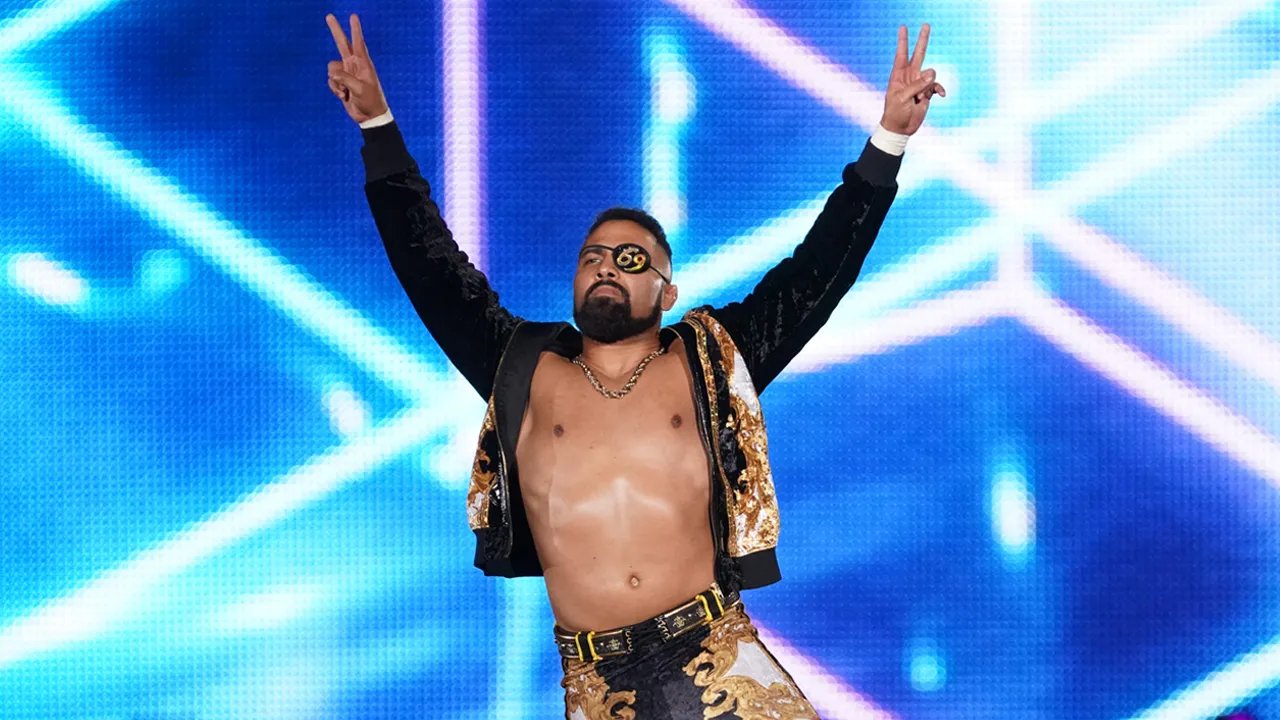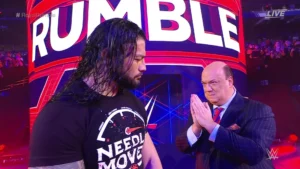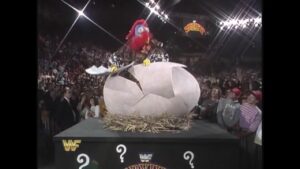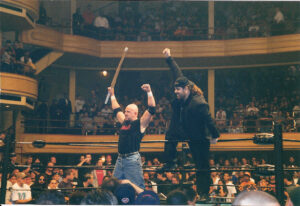The Current Trend
On Thursday, MLW presents its next PPV, Intimidation Games at the Melrose Ballroom in Queens, New York. A rundown of the full card and preview you can read here. It was not that long ago that MLW was at the Ballroom for their last PPV/taping of 2023. Yet within two months, a lot has changed. A noticeable pattern has developed. MLW is relying more and more on “outside” talent to carry the show. The number of “homegrown” talents on the card has decreased.
When I say “outside” talent, I mean both free agents and wrestlers whom most fans would associate with another company. Wrestlers who primarily compete or are associated with another wrestling company/brand, even if they have moved on.
When I say “homegrown”, I mean wrestlers primarily associated with the MLW brand itself. It’s important to acknowledge that since last year MLW has lost multiple wrestlers, depleting their ranks noticeably.
In the top title singles championship matches for Intimidation Games, the contests include wrestlers who have competed either this year or last year competed on TV and PPV for AEW, New Japan, and CMLL. Plus, elsewhere on the card, former WWE and AEW talent who are coming to MLW as part of the company’s “Open Door Policy”.
Earlier this month, I wrote about 3 things WWE and AEW could learn from MLW. One thing I cut from the list is that no other promotion perhaps best uses Paul Heyman’s ECW philosophy better: “accentuate the positives, hide the negatives”. However, while relying on outside talent is a way to compensate for what MLW is missing in the short-term, and long-term it could perpetuate a long-term trend that might diminish MLW and its identity further.
MLW’s Losses
MLW has been stagnant for several years because of various factors. It has resulted in the loss of high-profile homegrown wrestlers who have sought opportunities elsewhere.
From 2018-2019, there was a period of optimism for MLW’s future. With the right TV deal and distribution, MLW could have become a tertiary promotion in North America, behind WWE and Ring of Honor. Possibly stepping over Impact Wrestling, whose existence was the but of jokes. Often about how long until it finally died.
There were several blows to this hope. First, AEW came and changed the business. Like its spiritual predecessor, ECW, MLW suffered due to the actions of the market leaders. Part of AEW’s proposed USP indirectly took from MLW’s sports-orientated presentation.
Then both AEW and WWE mined the indies for talent. They signed both MLW fighters and their potential replacements in the Indies. Maxwell Jacob Freidman is the most notable. MLW signed some of its top talent to long-term deals as a response, which indirectly may have contributed to long-term issues.
Financial Issues
Further problems came in the form of the COVID-19 pandemic. The indies were hit the hardest, but MLW adapted. Fusion, the weekly one-hour YouTube show, produced creative and watchable pro wrestling. Yet the lack of revenue from shows and merchandising hurt the company financially.
As did the loss of promising TV and streaming deals, which resulted in a lawsuit against WWE. MLW CEO, Court Bauer said the loss of these deals “almost mortally wounded” the company. You can read about here.
The lawsuit resulted in a settlement in December. However, reports suggested that time and money spent on the lawsuit meant the company was close to shutting down. It also meant there was a lack of funds and time dedicated to growing the company, which held itself in a holding pattern.
MLW’s Talent Is the Company’s Strength
Part of the reason MLW looked to break out as a promotion was its booking of their “homegrown” wrestlers. Like the wrestlers of the original ECW, felt like they could slot nicely onto national TV with ease. MLW’s strength is its presentation of wrestling. Showing them at best with clear characters with their uniqueness cranked up to eleven.
However, the limited opportunities given through a one-hourly week show, its limited reach, and the vast changes in the pro wrestling landscape post-pandemic meant that several MLW wrestlers wanted to seek other opportunities.
An exodus of talent that has included former champions across divisions and the card. A possibly future heavyweight headliner, EJ Nduka, left in January of last year. Sam Adonis left in July of last year before his contract expired.
Former MLW World Tag Team Champions, The Samoan SWAT Team, Lance Anoa’i and Juicy Fina left in October. Taya Valkyrie, who was a former MLW Featherweight Champion, left in April, yet she was also working for the NWA and Impact simultaneously.
Company stalwarts also left. From The Von Erichs to Richard Holliday (although he has returned to the promotion, just not on a full-time contract like before). More recently Alex Hammerstone left in December, followed by Jacob Fatu this earlier month, who was the Atlas’ who held MLW up from 2018 to 2023.
This lack of opportunity and financial restrictions given my MLW have been suggested as reasons for looking for other options. Joey Janela in 2002 told Wrestling Observer Radio that one signed MLW talent was only guaranteed $14,000 over a three-year deal and restricted from working elsewhere.
Davey Boy Smith Jr during the Pandemic stated MLW “don’t pay talent when they are sitting at home bored out of their mind.”
The Accentuated Positives
Champions
The two top prizes of the men’s division are held by well-renowned and respected veterans of international wrestling. This, in the short term, has and continues to help MLW to get notice. The MLW World Middleweight Champion, Rocky Romero is one of the busiest men in wrestling both in the ring and behind the scenes.
Appearing here, there, and everywhere, some new reports on Rocky Romero online may include a reference to his MLW championship.
The MLW World Heavyweight Champion is the Japanese wrestling legend, Satoshi Kojima who beat Alex Kane for the championship at SuperFight at the start of February. A full analysis can be read here. Kojima is an MLW “original” in that he was the first officially recognized MLW World Heavyweight Champion.
With his victory, he became the first two-time MLW World Heavyweight Champion, which gained coverage in international wrestling magazines in Japan and Mexico.
For MLW, it also created an impressive kayfabe milestone and helped make their top championship seem incredibly prestigious. It also creates an interesting storyline by making Kojima MLW’s Terry Funk figure, a man many (including me) never expected to win the gold.
Both Rocky and Kojima are two stable, well-known wrestlers with strong reputations and cult followings.
Challengers and Newcomers
Their opponents at the Intimidation Games are likewise two big international wrestlers. Rocky’s opponent on Saturday is Mistico, the biggest box-office draw in Mexican wrestling history who also added AEW in drawing a bigger gate in Texas last year for a Rampage taping.
Kojima takes on everyone’s favorite Murder Grandpa, Minoru Suzuki in what will likely be a blistering match. Suzuki’s appeal has grown having competed on AEW, across the indies in the US and UK. Several times Suzuki has even made international news (see this BBC clip of Suzuki wrestling for DDT on a bullet train). Both challengers grab attention and potential viewers/customers. The match quality is guaranteed to be good at least.
Additionally, the return of other MLW “originals” like Matt Riddle and Sami Callihan is bolstering the card and bringing more recognition to the promotion.
Bobby Fish returning and AJ Francis debuting at Intimidation Games, both of whom have been set up as obstacles for former MLW Heavyweight Champion Alex Kane. Allowing the suplex assassin to beat more recognizable names will only add to Kane’s credibility.
If utilized properly, these ex-WWE guys can be positioned as gatekeepers to help young talent move up the card and build the next generation of homegrown headliners.
The Hidden Negatives
Gaps in Divisions
The greatest problem MLW is that if they continue to focus on replacing or substituting outside talent as flagbearers for the promotions, they will fail to address gaps in homegrown talent coming through the ranks. In the midcard and low card right now there is a lack of hierarchy and structure.
The old top ten rankings per division have become obsolete for a long time. Faction battles and storylines substitute for individual storylines.
The division where the problem is best exemplified in the featherweight division. At The Burning Crush, a four-way pitched Delmi Exo, Zayda, Tiara James, and Notorious Mimi against each other. Salina del la Renta was ringside on commentary and almost inadvertently buried the division.
Salina pointed out how frequently these women have wrestled with each other. Essentially, with B3CCA absent and Janai Kai as the champion, who is used sparingly to preserve her killer kickbox demon aura, these four women are the division.
Without any new additional women, Zayda, who MLW is presenting as someone to watch, has a ceiling and limited options. If she loses a title shot or loses to Exo, there is nothing new for her to achieve having beaten James and Mimi on multiple occasions.
Without levels, a hierarchy variety, and therefore depth, this limits the wrestler’s capacity to grow as much as their characters. Long-term then, why would the wrestlers stay with MLW?
If money instead goes to paying the higher fees for international globetrotting wrestlers, it means there is less money to bring in younger talent to fill in the noticeable gaps and allow a hierarchy to be built again.
Diluting and Samey
MLW’s slogan is Styles make fights.
The problem is beyond MLW’s control. Tony Khan and AEW, since blowing the hinges off “The Forbidden Door” have made dream matches, inter-promotional matches, and clash-of-styles matches an AEW hallmark. This has made the indie style mainstream, reducing MLW and the indie’s uniqueness.
Romero, Mistico, and Suzuki have appeared on AEW TV this year. Given they also wrestle for CMLL and NJPW, these wrestlers are not a “special attraction”.
Rocky is a confessed ambassador for New Japan and CMLL has now reportedly joined AEW in a backstage role. This means MLW is the last in a long list of promotions that he competes for, giving the impression that MLW is low in the pecking order of major league promotions.
The issue is MLW has made itself dependent on its inter-promotional relationships to sustain its PPV cards. If in the short-term, something changes in these relationships, then MLW’s talent pool is depleted further.
Conclusion- This is a Wider Trend
MLW is not the only promotion experiencing these issues. Even NJPW is experiencing a similar transition with talent leaving for AEW or elsewhere. It’s all part of the wider consequences of “The Forbidden Door” that I am going to touch on later this week.
In the short term, MLW is doing something incredibly smart to survive. They are giving themselves time to rebuild. If MLW begin spending money to build new homegrown talent, over time this may lead to them rebuilding their identity or a new identity.
In recent years it feels like MLW is the new Impact Wrestling. Some fans question how long until it dies completely. Well, Impact, is now TNA Wrestling and is still here. Given the turbulent history of the past decade and how MLW has survived, I have faith the company will persist in some form.
More From LWOS Pro Wrestling
Header photo – MLW – Stay tuned to the Last Word on Pro Wrestling for more on this and other stories from around the world of wrestling, as they develop. You can always count on LWOPW to be on top of the major news in the wrestling world, as well as to provide you with analysis, previews, videos, interviews, and editorials on the wrestling world. MLW FUSION airs every Thursday on YouTube at 8 PM EST and every Saturday on beIN SPORTS at 10 PM EST.






